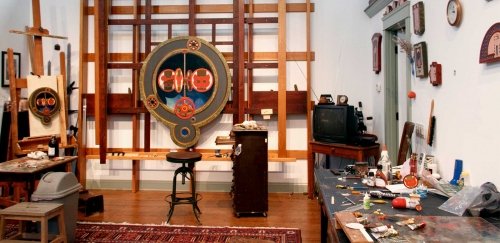
Richard Whitten is neither your typical artist nor your typical art collector. He “lives” in the worlds he paints. (Photo courtesy of David Demelim)

Whitten, an associate professor of art at Rhode Island College, describes his home/studio in Cranston, Rhode Island, as a “Wunderkammer,” or extended “wonder chamber” filled with curiosities. Wunderkammers, he explains, originated in Renaissance Europe and were the precursors of museums.
Whitten’s studio includes a collection of unknown specimens of natural history, antiquity, archaeology, ethnography and religious or historical relics. And these playful, engaging objects make their way into his paintings. “My Wunderkammer and my paintings are one of a piece,” Whitten said.
His latest body of work includes 25 paintings and associated sculptures and drawings, which he created during a yearlong sabbatical from the college in preparation for a huge series of shows over the next two years.
The first unveiling of some of his new work will be held on April 10 in an opening reception at the Anderson Gallery at Bridgewater State University in Bridgewater, Mass. The exhibition will run until May 20.
This installation consists of 14 images that follow Whitten’s artistic process from beginning to end – from drawing, to three-dimensional study model, to small study painting, to large-scale painting.
His paintings are noted for their rich, multicolored palette and for their use of geometric shapes. The images are of mechanical objects or reinvented antique toys placed within a Renaissance architectural setting. Whitten said he collects the toys and actually reconstructs them for his paintings.
Viewers also discover that Whitten likes to toy with their vision. His paintings force the eye to look through keyhole-shaped or otherwise cropped images and become curious peeping toms. Yet the viewer is never permitted completely inside. A viewer described feeling “transfixed by the images and then feeling somehow transported down Whitten’s illusory rabbit hole.”
In the Bridgewater exhibition, Whitten’s love of mechanical objects and his masterful use of trompe l’oeil or “fooling the eye” are clearly at work.
In his artist statement, Whitten writes: “My paintings are about play. My paintings are, in some ways, very serious toys. This does not mean, however, that they are frivolous. Play is a very serious activity – an impetus for learning and exploration. Neither is play nor my paintings all about fun. These paintings imply the existence of other places – “invisible cities” – that can be visualized, but, like the garden in Alice in Wonderland, can only be desired – not reached.”
“As I design these spaces, I answer simple demands,” he said, “to look down, to look around a corner, to look around a curve. The imagined architecture is designed to make the viewer look in a specific direction; to feel curious about what is partially hidden; to feel exhilarated by a vast expanse. As the images develop, they also take on references to the past: intimate niches, the vast vistas of the Renaissance painters, or the dramatically lit Baroque spaces of Piranesi – spaces that have a sense of history and place and meaning.”
Whitten’s home and studio have been featured in several local newspapers and magazines, while major exhibitions of his art have been held at the Frye Art Museum in Seattle, Wash., and at the Newport Art Museum.
